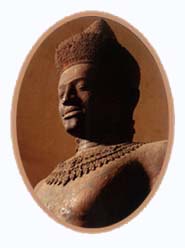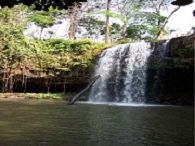
Cambodia's modem-day culture has its roots in the 1st to 6th centuries in a state referred to as Funan, known as the oldest Indianized state in Southeast Asia. It is from this period that evolved Cambodia's language, part of the Mon-Khmer family, which contains elements of Sanskrit, its ancient religion of Hinduism and Buddhism. Historians have noted, for example, that Cambodians can be distinguished from their neighbors by their clothing - checkered scarves known as Kramas are worn instead of straw hats. Funan gave way to the Angkor Empire with the rise to power of King Jayavarman II in 802. The following 600 years saw powerful Khmer kings dominate much of present day Southeast Asia, from the borders of Myanmar east to the South China Sea and north to Laos. It was during this period that Khmer kings built the most extensive concentration of religious temples in the world - the Angkor temple complex. The most successful of Angkor's kings, Jayavarman II, Indravarman I, Suryavarman II and Jayavarman VII, also devised a masterpiece of ancient engineering: a sophisticated irrigation system that includes barays (gigantic man-made lakes) and canals that ensured as many as three rice crops a year. Part of this system is still in use today.
The Khmer Kingdom (Funan)
Early Chinese writers referred to a kingdom in Cambodia that they called Funan. Modern-day archaeological findings provide evidence of a commercial society centered on the Mekong Delta that flourished from the 1st century to the 6th century. Among these findings are excavations of a port city from the 1st century, located in the region of Oc-Eo in what is now southern Vietnam. Served by a network of canals, the city was an important trade link between India and China. Ongoing excavations in southern Cambodia have revealed the existence of another important city near the present-day village of Angkor Borei. A group of inland kingdoms, known collectively to the Chinese as Zhenla, flourished in the 6th and 7th centuries from southern Cambodia to southern Laos. The first stone inscriptions in the Khmer language and the first brick and stone Hindu temples in Cambodia date from the Zhenla period.
Angkor Era
Bayon Temple, Angkor Thom The giant faces carved on the Bayon temple at the Angkor Thum complex in northwestern Cambodia represent both the Buddha and King Jayavarman VII (ruled about 1130-1219). Although a Buddhist temple, Angkor Thum was modeled after the great Hindu temple complex of Angkor Wat. In the early 9th century a Khmer (ethnic Cambodian) prince returned to Cambodia from abroad. He probably arrived from nearby Java or Sumatra, where he may have been held hostage by island kings who had asserted control over portions of the Southeast Asian mainland. In a series of ceremonies at different sites, the prince declared himself ruler of a new independent kingdom, which unified several local principalities. His kingdom eventually came to be centered near present-day Siemreab in northwestern Cambodia. The prince, known to his successors as Jayavarman II, inaugurated a cult honoring the Hindu god Shiva as a devaraja (Sanskrit term meaning "god-king"). The cult, which legitimized the king's rule by linking him with Shiva, persisted at the Cambodian court for more than two hundred years. Between the early 9th century and the early 15th century, 26 monarchs ruled successively over the Khmer kingdom (known as Angkor, the modern name for its capital city).
 King Jayavarman VII, the successors of Jayavarman II built the great temples for which Angkor is famous.
Historians have dated more than a thousand temple sites and over a thousand stone inscriptions (most of them on temple walls) to this era.
Notable among the Khmer builder-kings were Suyavarman II, who built the temple known as Angkor Wat in the mid-12th century, and Jayavarman VII, who built the Bayon temple at Angkor Thum and several other large Buddhist temples half a century later. Jayavarman VII, a fervent Buddhist, also built hospitals and rest houses along the roads that crisscrossed the kingdom. Most of the monarchs, however, seem to have been more concerned with displaying and increasing their power than with the welfare of their subjects.
Ancient City of Angkor This map shows the layout of the ancient city of Angkor, capital of the Cambodian Khmer kingdom from the 9th century to the 15th century. The city's huge stone temples were both civic centers and religious symbols of the Hindu cosmos. Historians believe that Angkor's network of canals and barays (reservoirs) were used for irrigation.
At its greatest extent, in the 12th century, the Khmer kingdom encompassed (in addition to present-day Cambodia) parts of present-day Vietnam, Laos, Thailand, Myanmar (formerly Burma), and the Malay Peninsula. Thailand and Laos still contain Khmer ruins and inscriptions. The kings at Angkor received tribute from smaller kingdoms to the north, east, and west, and conducted trade with China. The capital city was the center of an impressive network of reservoirs and canals, which historians theorize supplied water for irrigation. Many historians believe that the abundant harvests made possible by irrigation supported a large population whose labor could be drawn on to construct the kings' temples and to fight their wars. The massive temples, extensive roads and waterworks, and confident inscriptions give an illusion of stability that is undermined by the fact that many Khmer kings gained the throne by conquering their predecessors. Inscriptions indicate that the kingdom frequently suffered from rebellions and foreign invasions.
Historians have not been able to fully explain the decline of the Khmer kingdom in the 13th and 14th centuries. However, it was probably associated with the rise of powerful Thai kingdoms that had once paid tribute to Angkor, and to population losses following a series of wars with these kingdoms. Another factor may have been the introduction of Theravada Buddhism, which taught that anyone could achieve enlightenment through meritorious conduct and meditation. These egalitarian ideas undermined the hierarchical structure of Cambodian society and the power of prominent Hindu families. After a Thai invasion in 1431, what remained of the Cambodian elite shifted southeastward to the vicinity of Phnom Penh.
King Jayavarman VII, the successors of Jayavarman II built the great temples for which Angkor is famous.
Historians have dated more than a thousand temple sites and over a thousand stone inscriptions (most of them on temple walls) to this era.
Notable among the Khmer builder-kings were Suyavarman II, who built the temple known as Angkor Wat in the mid-12th century, and Jayavarman VII, who built the Bayon temple at Angkor Thum and several other large Buddhist temples half a century later. Jayavarman VII, a fervent Buddhist, also built hospitals and rest houses along the roads that crisscrossed the kingdom. Most of the monarchs, however, seem to have been more concerned with displaying and increasing their power than with the welfare of their subjects.
Ancient City of Angkor This map shows the layout of the ancient city of Angkor, capital of the Cambodian Khmer kingdom from the 9th century to the 15th century. The city's huge stone temples were both civic centers and religious symbols of the Hindu cosmos. Historians believe that Angkor's network of canals and barays (reservoirs) were used for irrigation.
At its greatest extent, in the 12th century, the Khmer kingdom encompassed (in addition to present-day Cambodia) parts of present-day Vietnam, Laos, Thailand, Myanmar (formerly Burma), and the Malay Peninsula. Thailand and Laos still contain Khmer ruins and inscriptions. The kings at Angkor received tribute from smaller kingdoms to the north, east, and west, and conducted trade with China. The capital city was the center of an impressive network of reservoirs and canals, which historians theorize supplied water for irrigation. Many historians believe that the abundant harvests made possible by irrigation supported a large population whose labor could be drawn on to construct the kings' temples and to fight their wars. The massive temples, extensive roads and waterworks, and confident inscriptions give an illusion of stability that is undermined by the fact that many Khmer kings gained the throne by conquering their predecessors. Inscriptions indicate that the kingdom frequently suffered from rebellions and foreign invasions.
Historians have not been able to fully explain the decline of the Khmer kingdom in the 13th and 14th centuries. However, it was probably associated with the rise of powerful Thai kingdoms that had once paid tribute to Angkor, and to population losses following a series of wars with these kingdoms. Another factor may have been the introduction of Theravada Buddhism, which taught that anyone could achieve enlightenment through meritorious conduct and meditation. These egalitarian ideas undermined the hierarchical structure of Cambodian society and the power of prominent Hindu families. After a Thai invasion in 1431, what remained of the Cambodian elite shifted southeastward to the vicinity of Phnom Penh..jpg)
.jpg)
.jpg)
.jpg)



